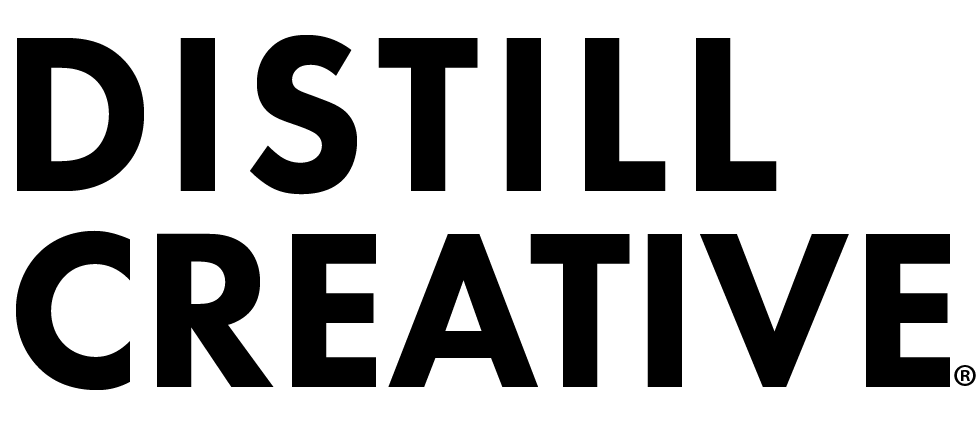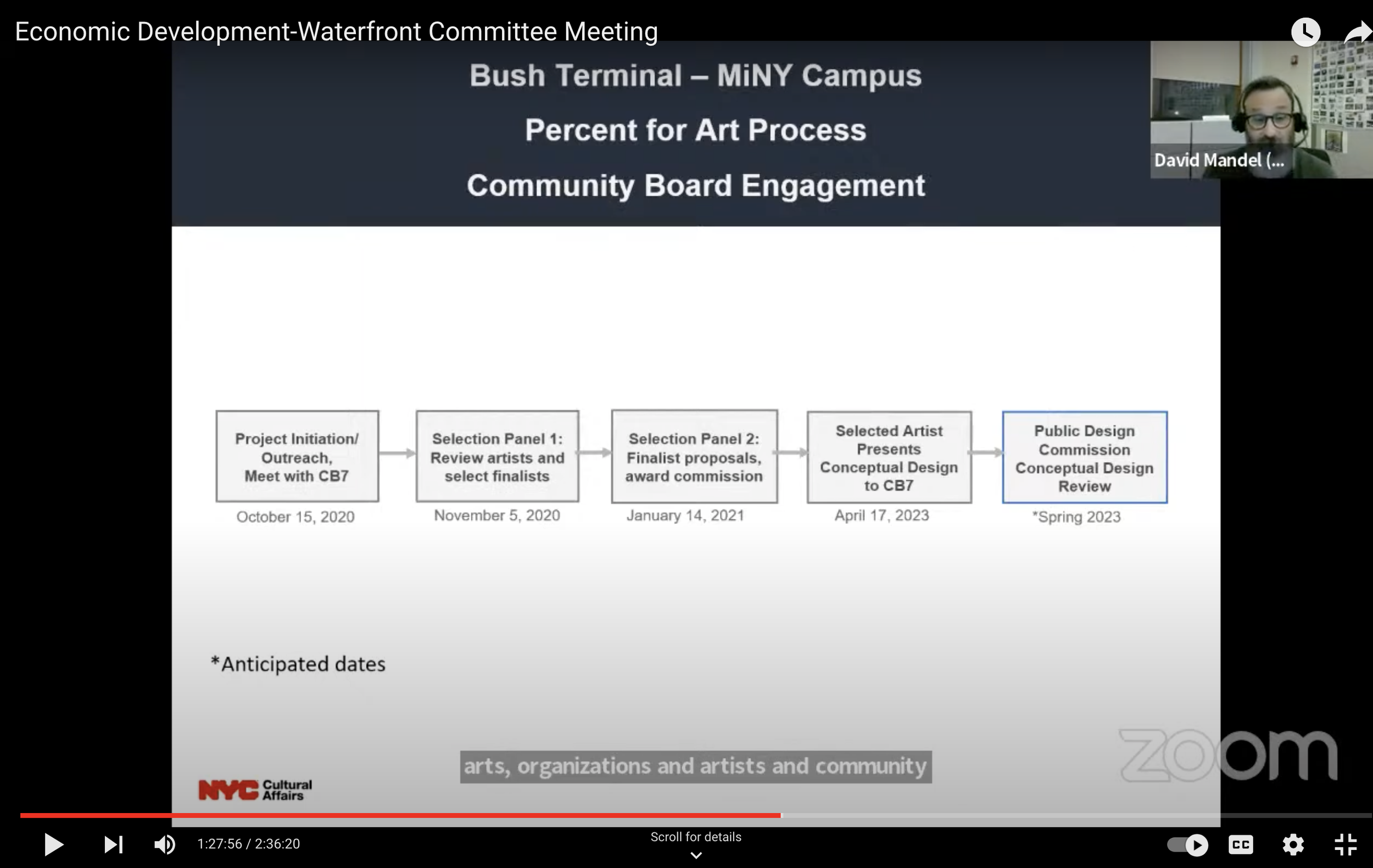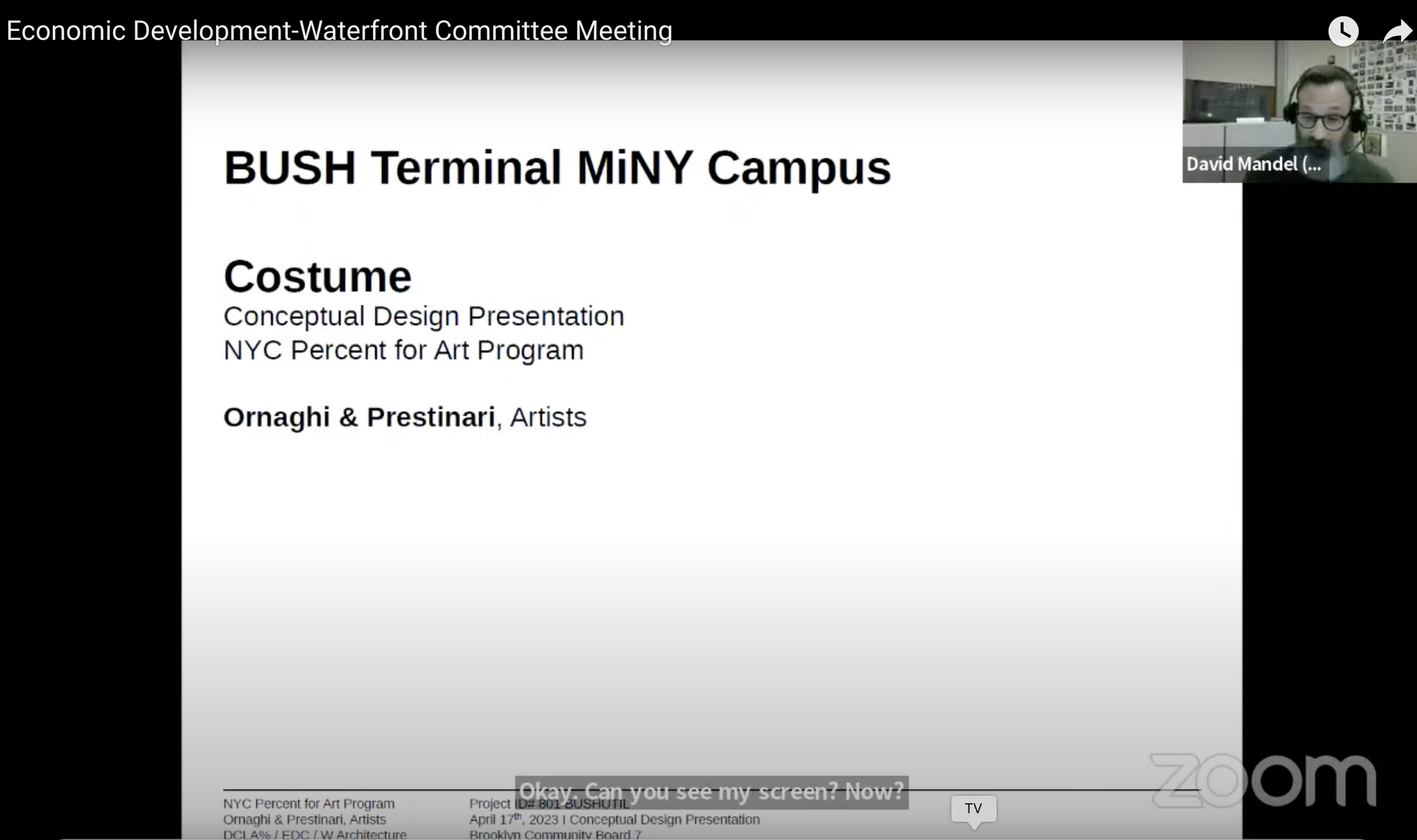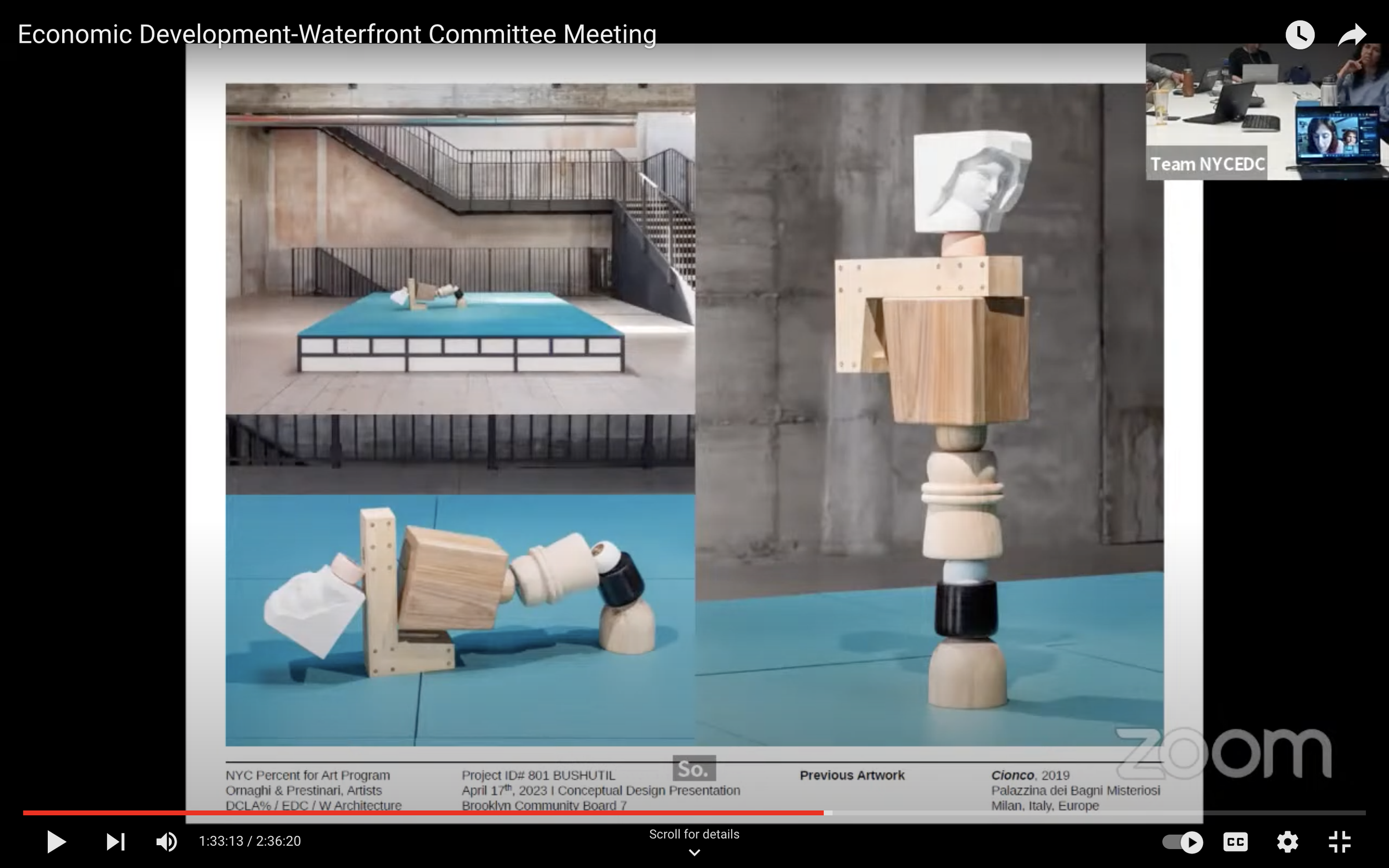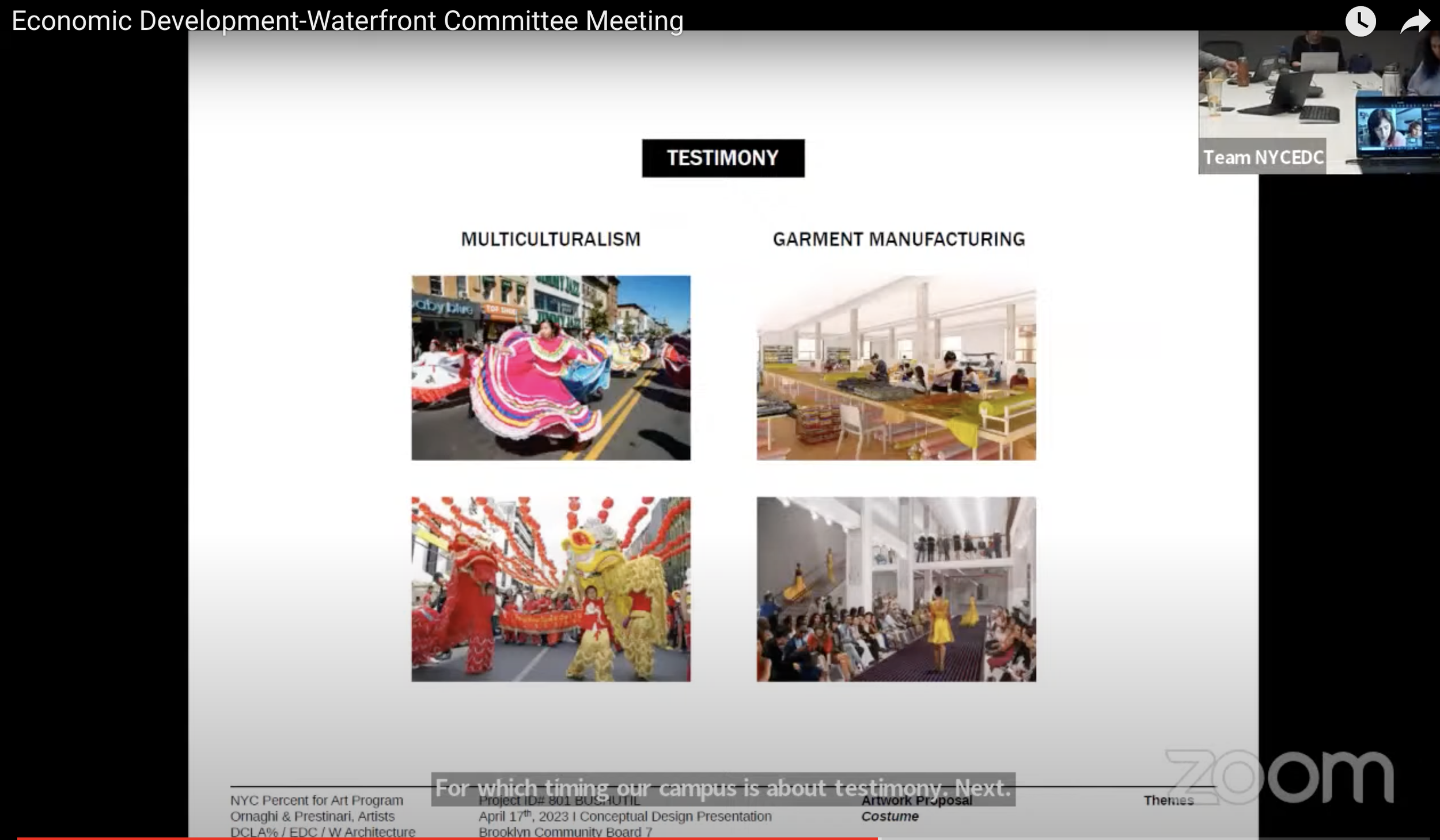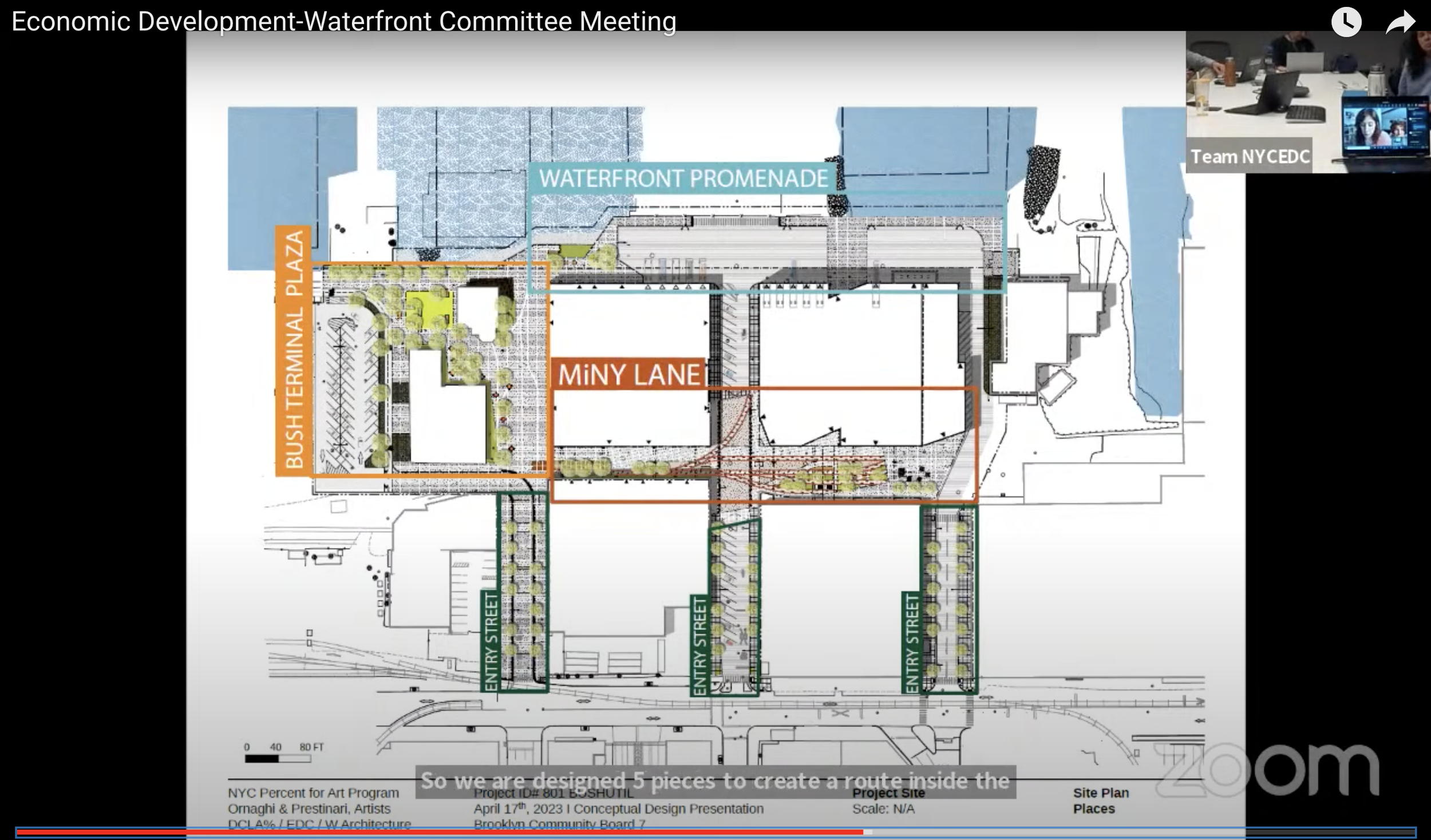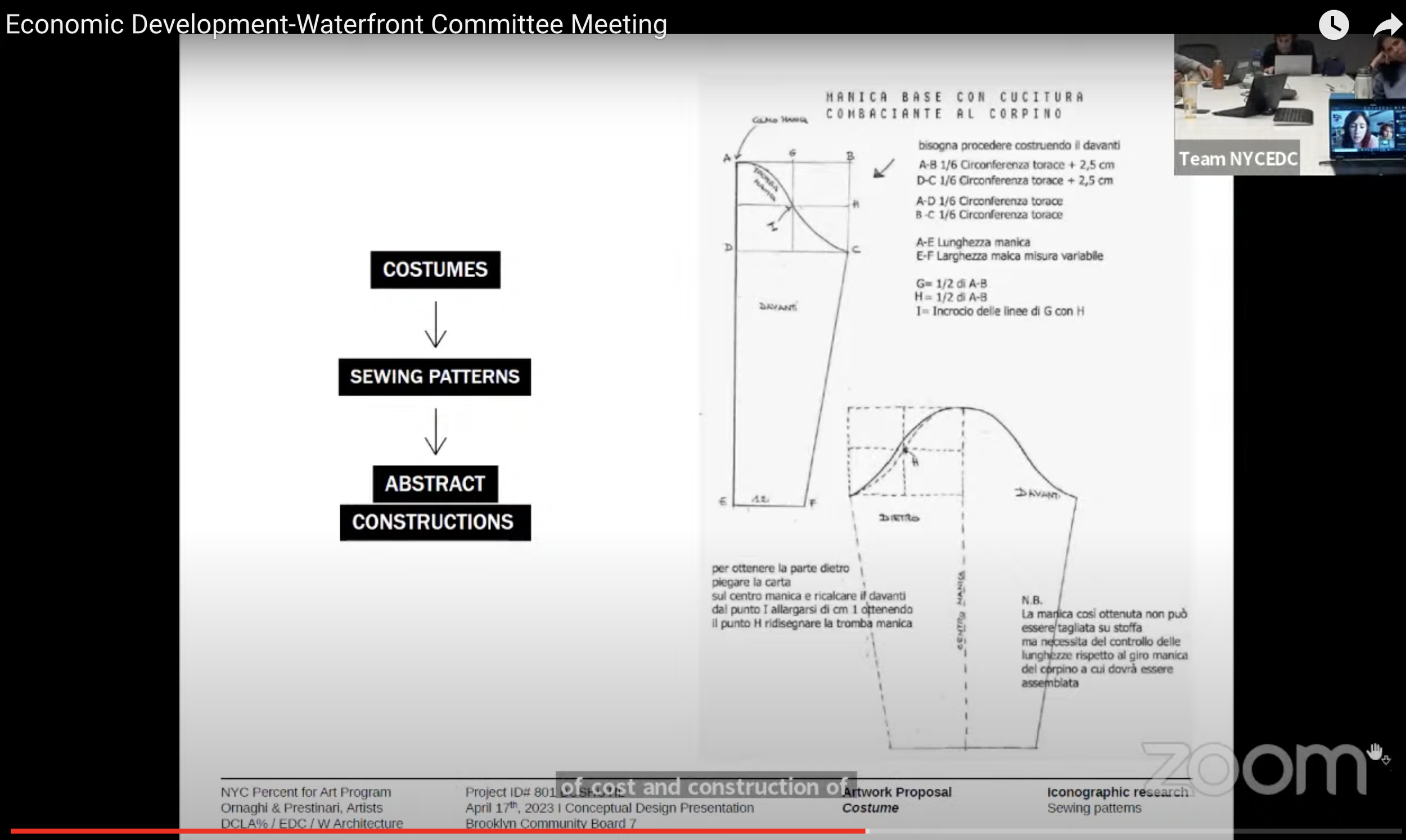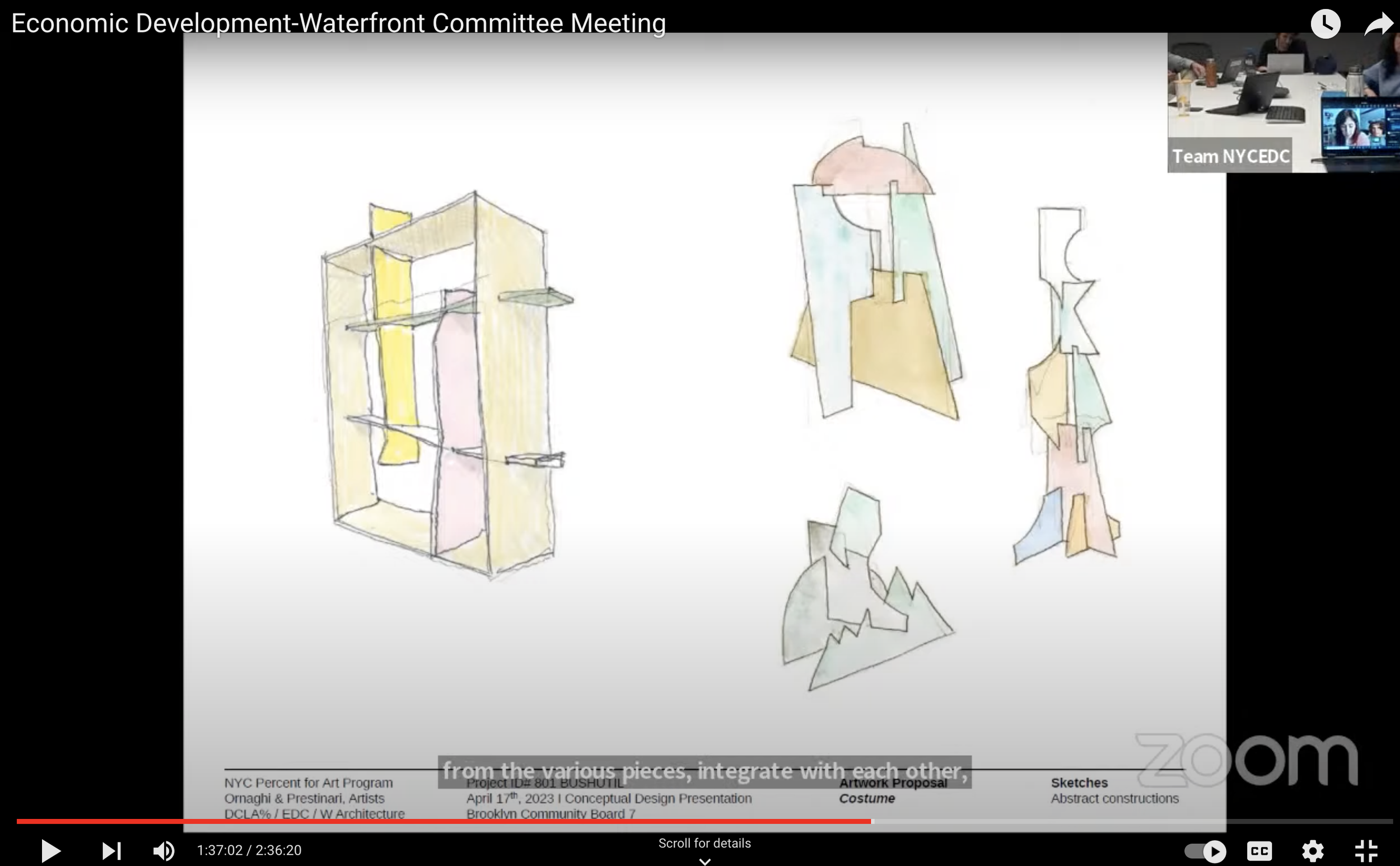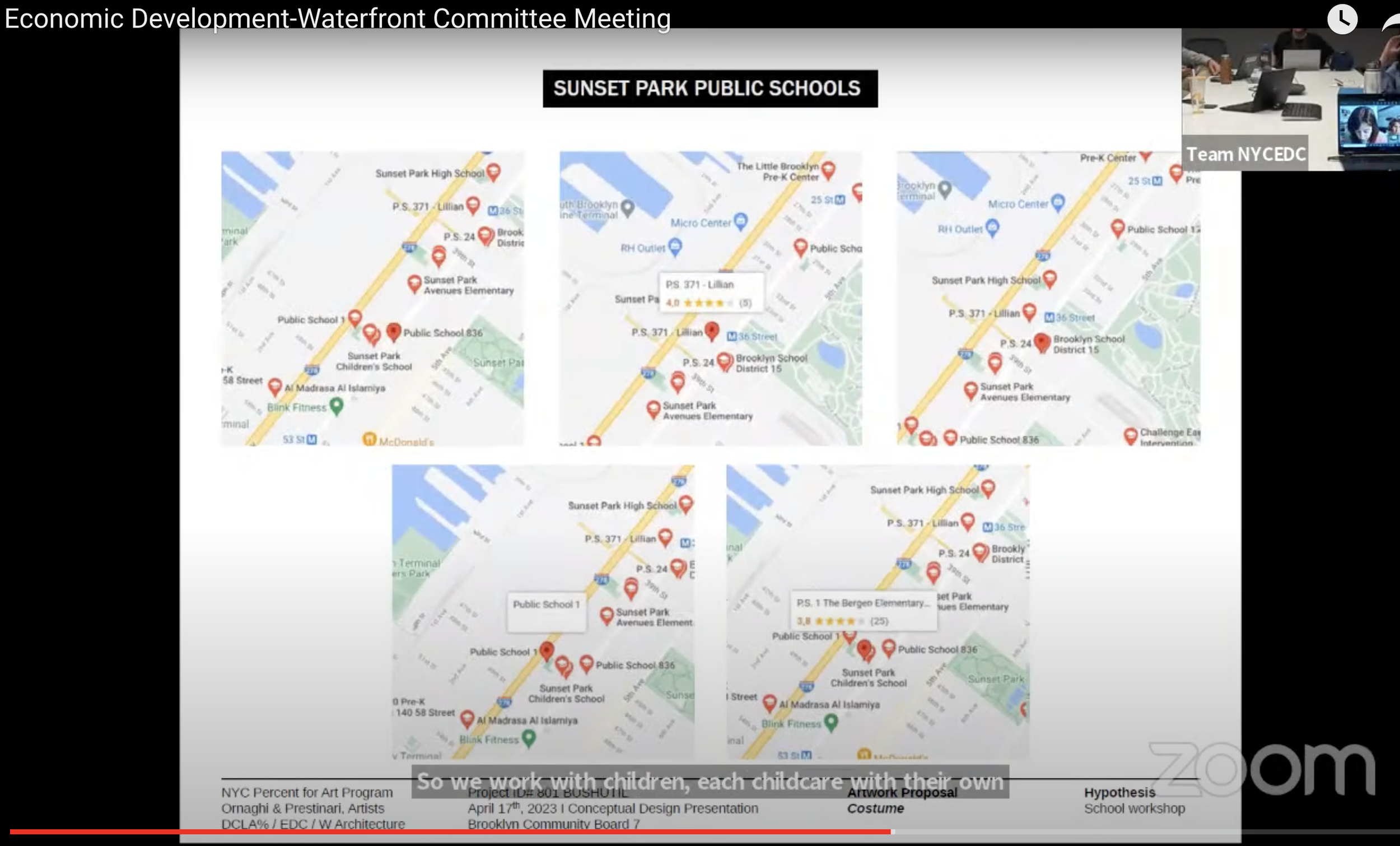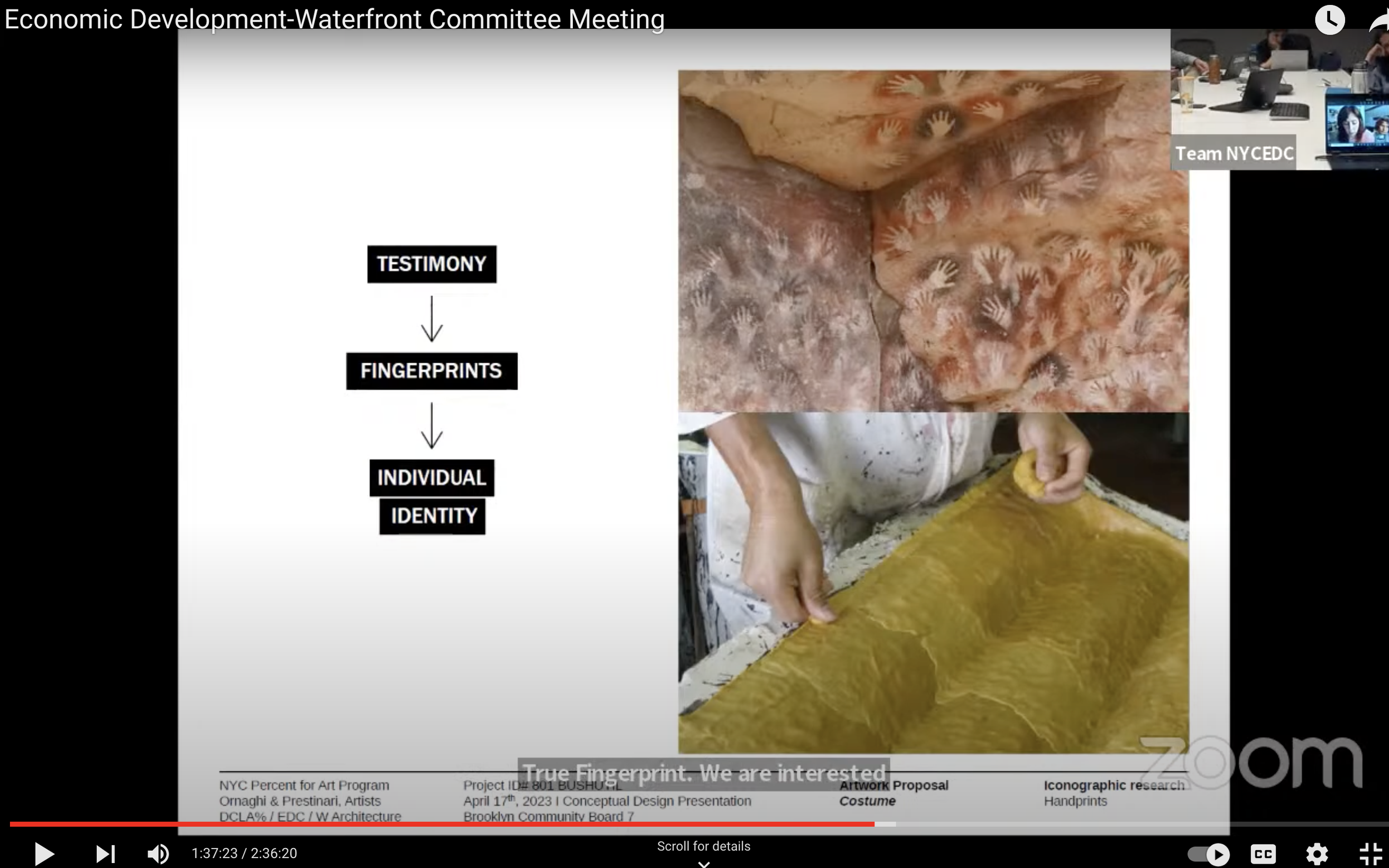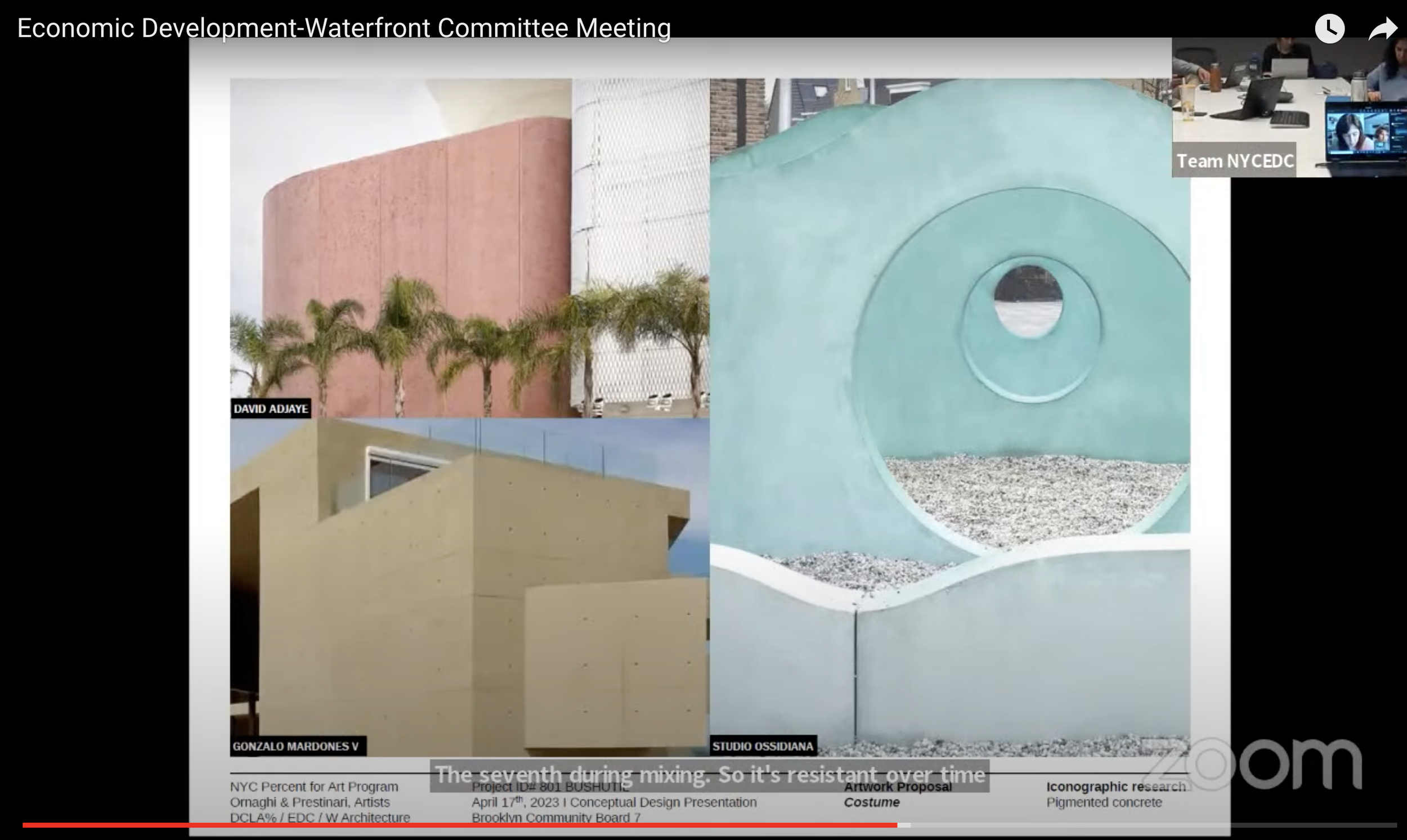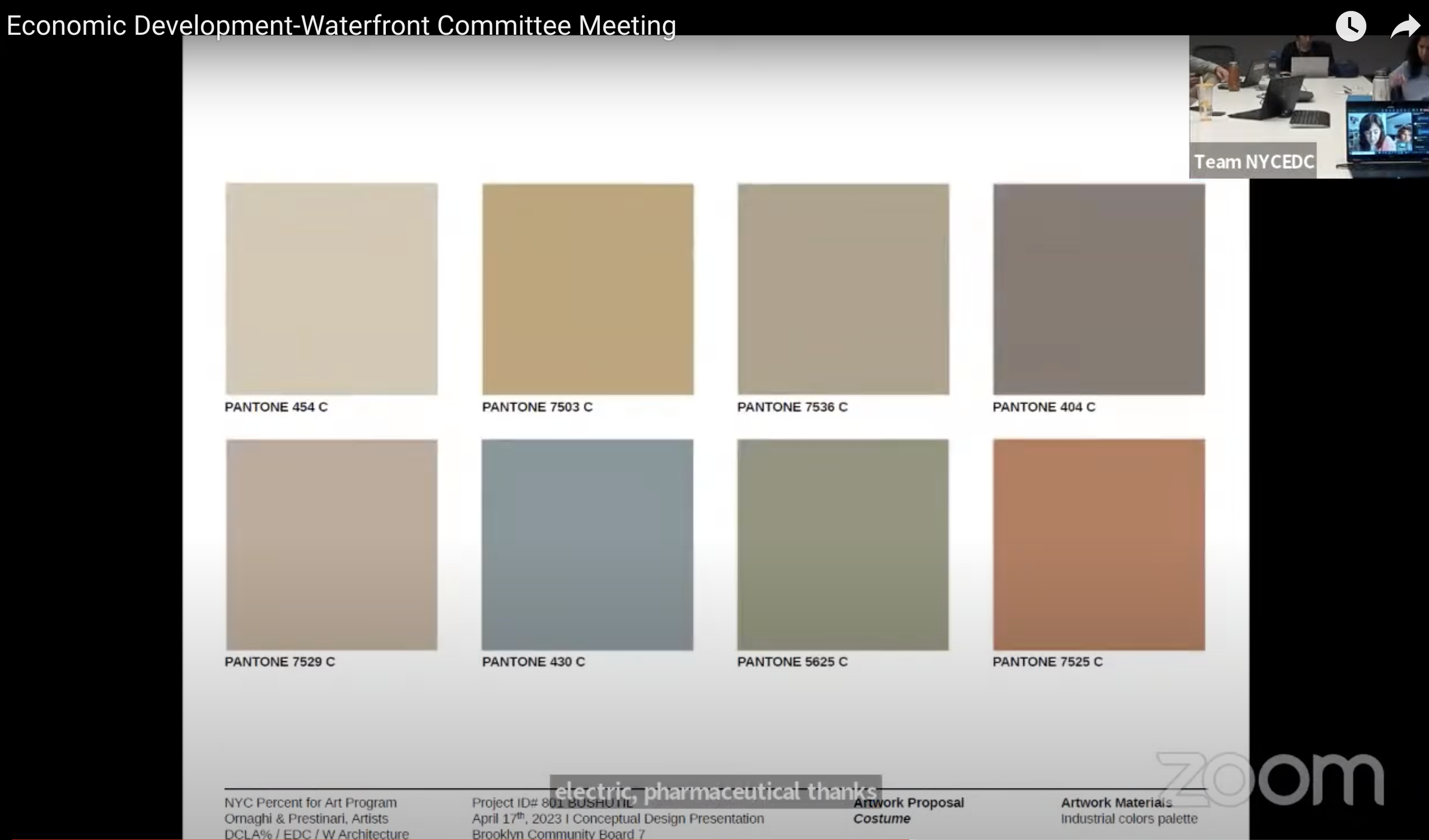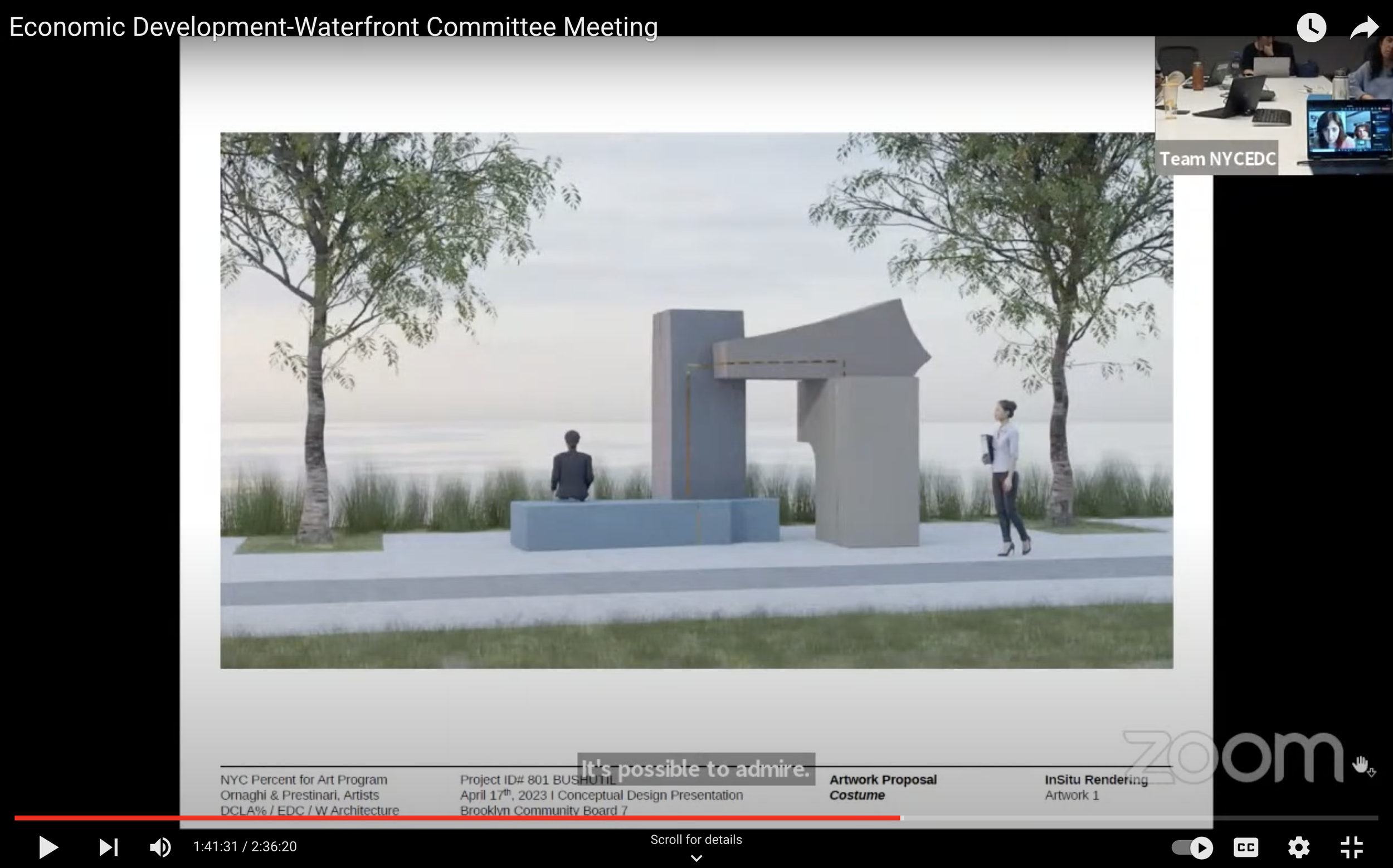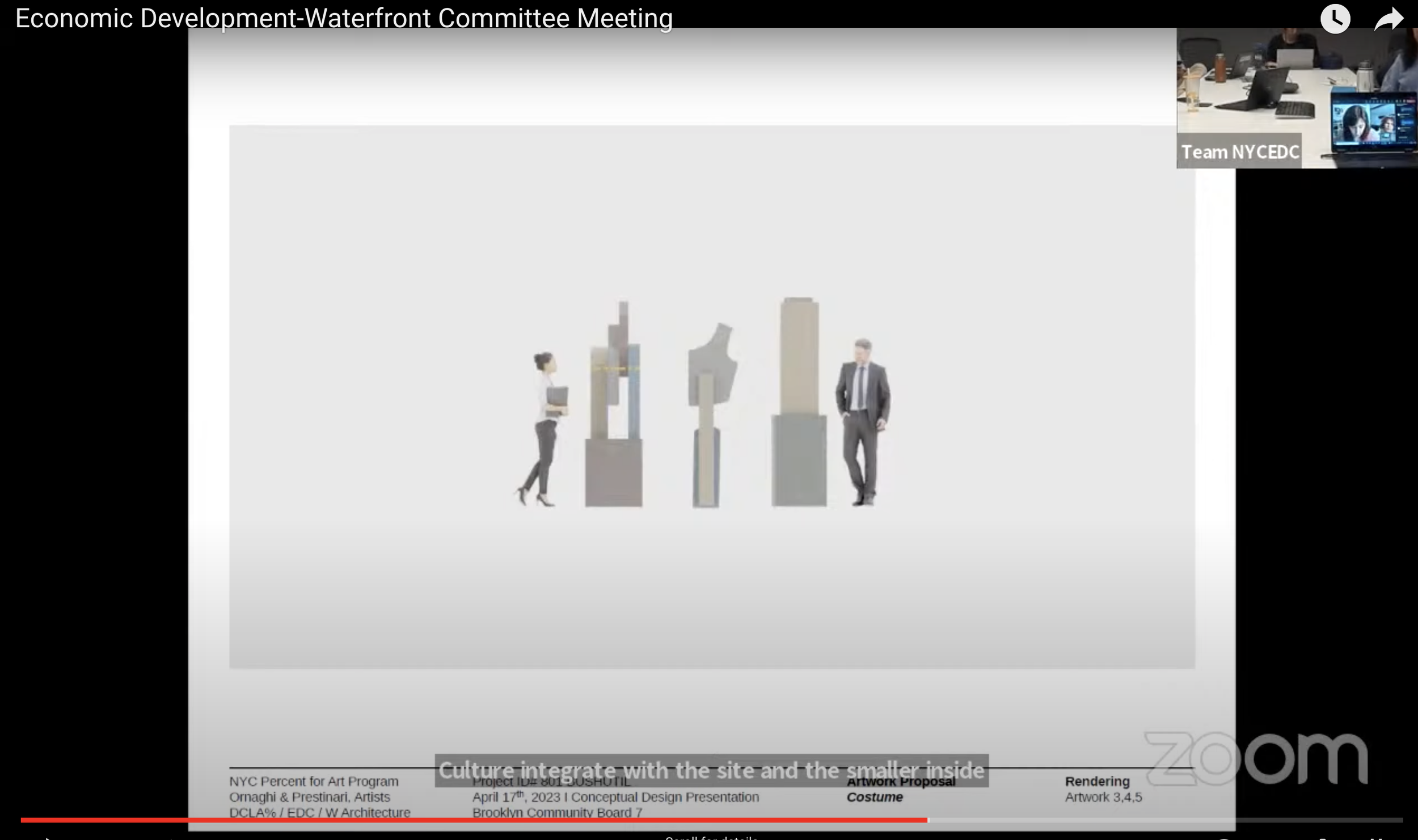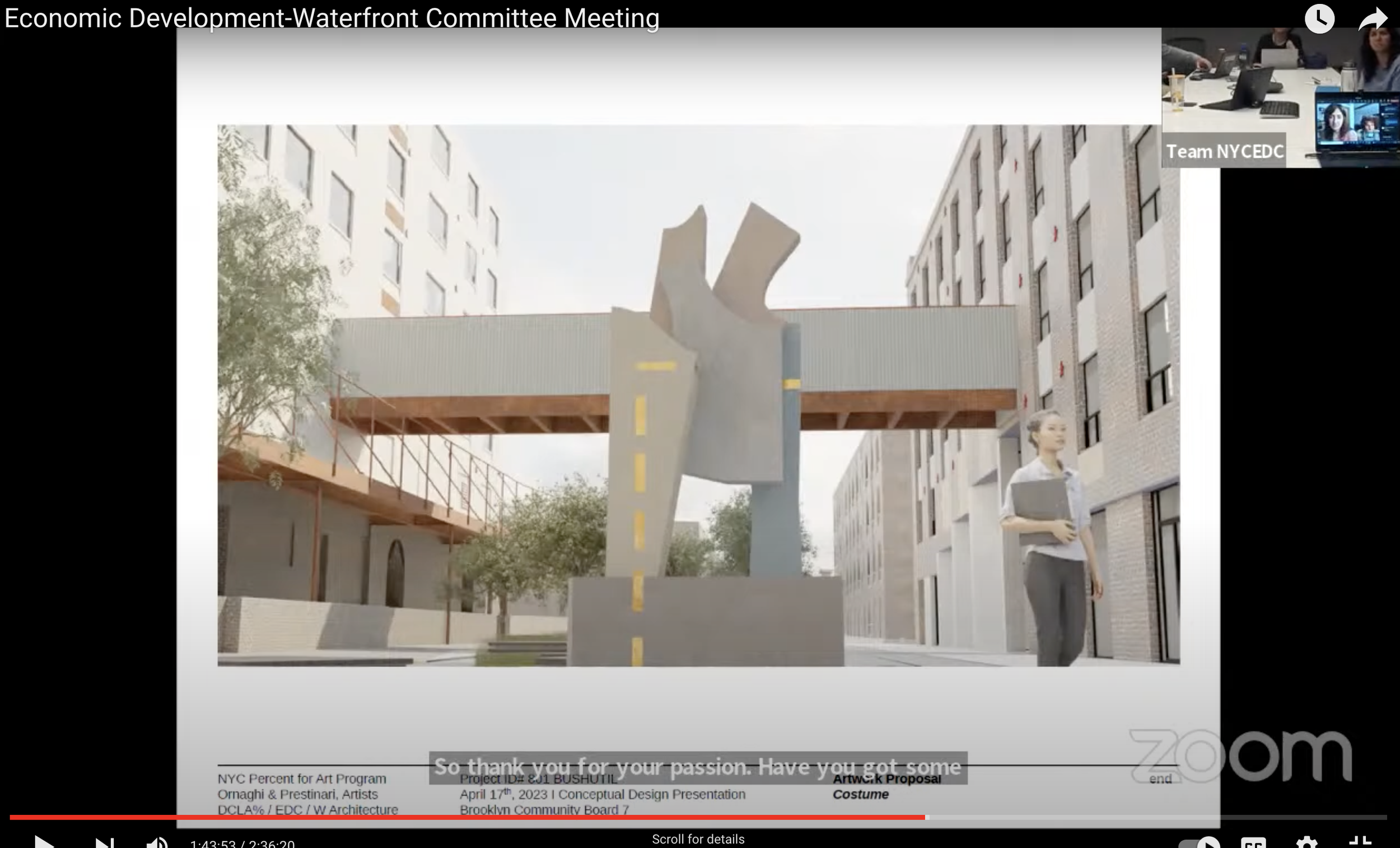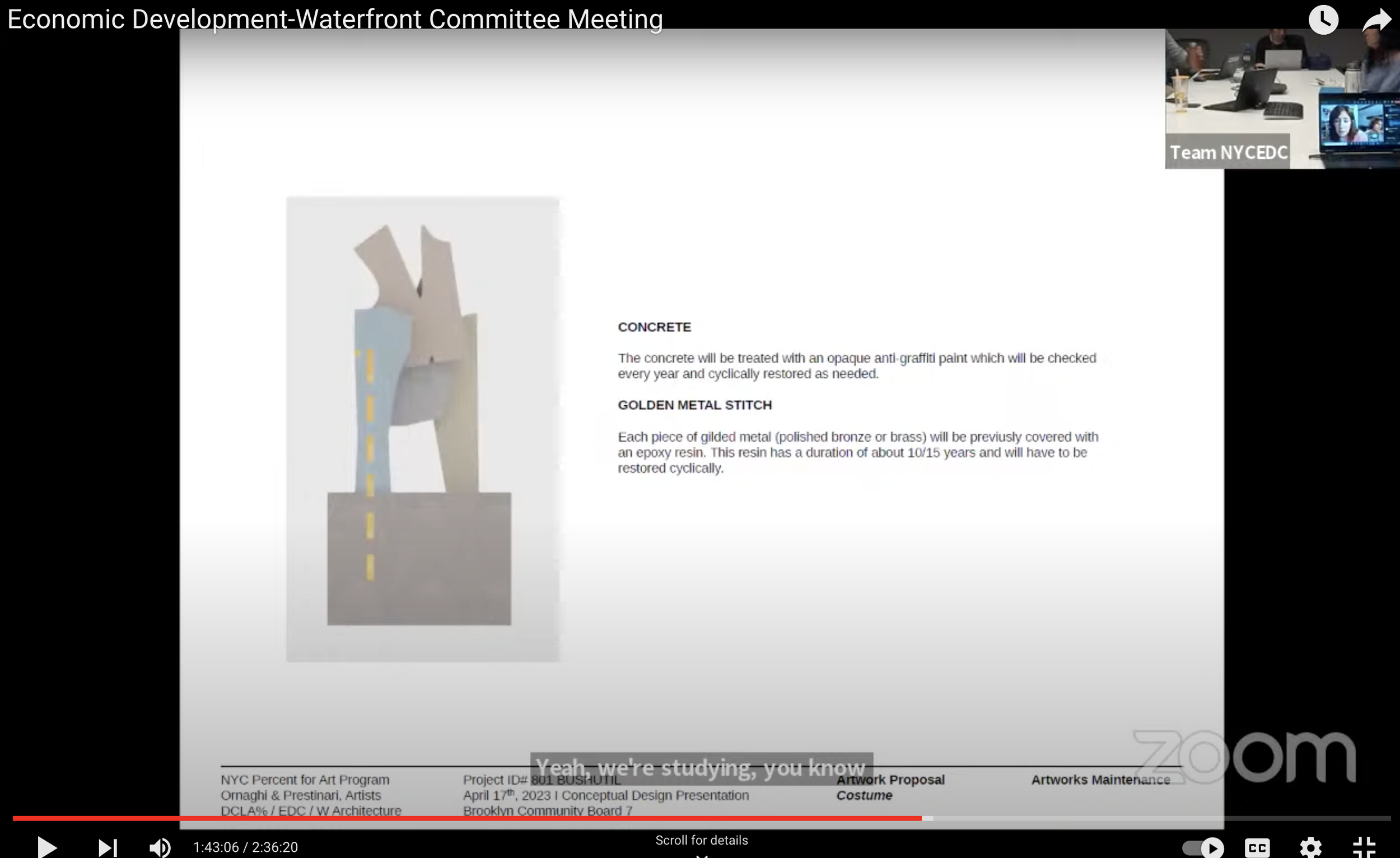Public Art in Sunset Park Fail: Bush Terminal Park's Made in NY Project Proposal by DCA and Italian artists Ornaghi & Prestinari
Screenshot of artist (Ornaghi & Prestinari) proposal presentation to Brooklyn Community Board #7 Economic Development-Waterfront Committee Meeting (April 17, 2023 via YouTube)
Earlier today I was digging into the Made in New York (MiNY) project that is currently under construction near Bush Terminal Park in Sunset Park. The NYC EDC-led project is gut-renovating two historic buildings and promises a 500,000-square-foot film and tv production hub, 2,200 new jobs, and 5.3 acres of new public space adjacent to the existing Bush Terminal Piers Park. Most importantly, more waterfront public access via Pier 6 and public spaces around Buildings A and C and the entrance to Bush Terminal Park. Besides Bush Terminal Park, Sunset Park has no waterfront access that is publicly accessible and not nearly enough green space to support the community.
Screenshot of Google Map view of Sunset Park. The big green area is Green-Wood Cemetery, which is amazing, but it is not a public space. You cannot run, walk a dog, or sit on the grass because it is an active cemetery. They have great programming, but it is not a public park.
Screenshot of NYC EDC presentation to Brooklyn Community Board #7 Economic Development-Waterfront Committee Meeting (April 17, 2023 via YouTube)
I was initially doing research on another project I’m pursuing, creating a waterfront pocket park at 23rd Street and 3rd Ave, which is a city-owned lot currently being used as a vacant NYPD parking lot. This idea was the most voted-on participatory budgeting project in 2022, but Parks and Rec shot it down. More on that to come.
To find out more about the recent updates for the Made in NY campus project I started watching the Community Board 7 April Board Meeting because public art for the Made in NY (MiNY) campus was on the agenda. I have been a consultant on projects like this (for projects in Washington, DC, where I used to live) and have been on the side of the developers (when I was placemaking manager for Vornado/JBG Smith in northern Virginia) back when I lived in DC. Through my experience as an art consultant, as an employee for a major REIT, and as an artist, I know first hand how complex these situations can be and how difficult it is to create art in public space in any capacity that actually engages or even acknowledges the historic, present, and future community.
I am an advocate for more transparency in public art via my podcast First Coat, this blog, and the types of projects I work on, both as a consultant and an artist myself. Thus, when I saw (via the YouTube recording) that the Community Board 7 April meeting voted to postpone the vote to give a letter of support to the Department of Cultural Affairs for their proposed One Percent for Art project at the Sunset Park MiNY campus, I had to learn more. (It’s kind of ridiculous, they couldn’t vote because no one had details or minutes on the Brooklyn Community Board #7 Economic Development-Waterfront Committee Meeting that had been held April 17, 2023, that happened two days earlier.)
I found that meeting and I watched it, despite boring both my husband and one-year old.
And this is what I found: a great example of a public art fail.
NYC’s One Percent for Art program was created in 1982 and requires that one percent of the budget for eligible City-funded construction projects be spent on artwork for City facilities. The projects are administrated by NYC’s Department of Cultural Affairs (referred to as DCA) and they have completed over 300 projects (385+ according to the meeting) and over $41 million of art work commissions.
I love many of the projects this program has funded and I’m a big fan of DCA in general, but in this specific case I think they truly underserved us, the NYC public that wants our one percent for art.
One major issue I have with public art, both public and privately funded, is that it is a black box of bureaucracy, nepotism, and classism. There is an over representation of white, male artists (especially architects) and a lack of representation of Black, Indigenous, or People of Color, especially BIPOC women, or any kind of self-taught or non-MFA/BFA holding artists. If you want to get paid real money to make something that will be preserved in public space, you really have to have connections, access to capital, and a CV.
I have ideas on how to help improve this, but for this post I would just like to share what was presented, as I understand it, and my general thoughts on this project because it was just so painful to see the attendees of the Community Board 7 Economic Development-Waterfront Committee meeting voice their very reasonable frustrations and know, deep down, that DCA is probably going to push through this public art project or something very similar to what was presented, anyway.
DCA started the public art portion of the meeting by explaining their process, which I’m sure is tried and true. However, they were not able to say if any of the artists included in their review panel are from the local community near the Made in NY campus in Sunset Park, which is lame.
Screenshot of NYC Department of Cultural Affairs presentation to Brooklyn Community Board #7 Economic Development-Waterfront Committee Meeting (April 17, 2023 via YouTube)
Screenshot of NYC Department of Cultural Affairs presentation to Brooklyn Community Board #7 Economic Development-Waterfront Committee Meeting (April 17, 2023 via YouTube)
Note that the process started in October, 2020, which was a hard time for all of us, especially the working class community of Sunset Park. I wonder if the people who reviewed the artists were even in NYC at the time, or if they were on a Zoom call, attending remotely from somewhere else, but that’s just my cynical speculation.
Anyhow, presumably DCA did ‘outreach’ with Community Board 7 (CB7) and presumably there was an opportunity for CB7 to suggest artists, at least that is what the DCA representative on the call said.
If you would like to submit yourself as an artist to be considered for One Percent for Art projects in NYC, you can submit your work by filling out a form here.
I want to trust the process, but it would be nice if either there were more opportunities for the community to be involved in the selection of artists or creation of concept, perhaps by making it more clear how one might be able to be on the board of this process for projects in their own community or presenting more often to the local community board.
I know, this seems like a way to draw out an already drawn out process or put too many cooks in the kitchen to create a work of art.
But, these projects are not short-term experiments. They are permanent works that will be in the public realm for, presumably, a lifetime, if not longer.
After the DCA representative shared the process, the artist, Valentina Ornaghi (part of Ornaghi and Prestinari) shared their inspiration and concept. I don’t want to shit on their work or concept too much because I trust they really did consider the place, the ‘community’, and the context of their proposed public artwork, but it was truly lackluster.
Screenshot of artist (Ornaghi & Prestinari) proposal presentation to Brooklyn Community Board #7 Economic Development-Waterfront Committee Meeting (April 17, 2023 via YouTube)
Screenshot of artist (Ornaghi & Prestinari) image of previous artwork presented to Brooklyn Community Board #7 Economic Development-Waterfront Committee Meeting (April 17, 2023 via YouTube)
Screenshot of artist (Ornaghi & Prestinari) inspiration presented to Brooklyn Community Board #7 Economic Development-Waterfront Committee Meeting (April 17, 2023 via YouTube)
They said they drew inspiration from the ‘multiculturalism’ and ‘garment manufacturing’ of the current and future site, especially the Latino and Asian communities (this very unfortunate sketch shows just how ridiculously surface level their understanding of these complex, multi-faceted communities may actually be):
Screenshot of artist (Ornaghi & Prestinari) proposal presentation to Brooklyn Community Board #7 Economic Development-Waterfront Committee Meeting (April 17, 2023 via YouTube)
I agree with one of the meeting attendees that the public artwork for this site (or any site) need not be literal or representational, that is not the only way to be respectful or informed by a place and its people, but, like another meeting attendee voiced, what is the connection, exactly, to Bush Terminal Park, to Sunset Park, to Brooklyn, to NYC, to waterfronts in general, to anything related to the place?
The artwork does seem heavily inspired by the future use of the site as a place for garment manufacturing. The Made in NY campus hopes to be a garment manufacturing hub. This is cool. This is hip. But what about what already is and has been? This waterfront area was not historically a place of manufacturing, but rather a place of transport, where the ships would come in and drop the shipping containers before they were transported out by land.
This wouldn’t be such a big deal if we had a handful of other One Percent for Art or otherwise funded (and maintained) public artworks in the neighborhood that had a diversity of style and artists who created them. But we don’t. We have murals, which are wonderful, but we deserve monuments. We deserve lasting public art and when there are so few opportunities for this to be funded and maintained, can’t we have at least the illusion of a connection to the existing and historic communities and place?
The proposed artists for this project are Ornaghi and Prestinari. They were born in and live and work in Milan, Italy. Again, this would not be so annoying if we had lots of other permanent works by local (this is NYC, we have professionals) artists in the surrounding Sunset Park community, but we don’t (please share in the comments below if we do and I’m missing them).
I don’t doubt their talent or expertise as artists, but come on. This was the best DCA and their panel could do? Find a duo of Italian artists, and not even from a coastal city?
As for their proposed work, they talked about being inspired by garments and patterns and industrial colors. They want to bring in local children to, from what I understand, use their fingerprints to create the texture in the colored concrete. I very much don’t like the idea of my toddler’s contribution to her local public art being her fingerprints on a contemporary concrete slab in the color of pastel rust, in the form of a deconstructed pattern piece (that doesn’t even seem to reference a traditional or contemporary Mexican or Chinese garment, which both have very rich textile traditions).
Above: Screenshots of artist (Ornaghi & Prestinari) proposal presentation to Brooklyn Community Board #7 Economic Development-Waterfront Committee Meeting (April 17, 2023 via YouTube)
I watched the whole two hour and thirty-six minute meeting. I just wanted you to know. I feel bad taking screenshots and pulling them out of the meeting context, but you can watch the whole meeting yourself if you want to know what was said and how it was presented: Brooklyn Community Board #7 Economic Development-Waterfront Committee Meeting (April 17, 2023 via YouTube).
I don’t hate the actual artwork. I don’t hate the artists. I hate hearing the words ‘community’ and ‘multiculturalism’ and ‘youth’ without anyone seeming to actually dig deep into what they mean. I hate seeing big art commissions going to Europeans, again, particularly for this specific project, which is a major, unique waterfront development project in a very diverse (in race, class, culture, language, age) community. I hate having to watch a two-hour+ meeting to know what the hell is going on in my neighborhood. I hate being a public art professional and a working artist and still not really knowing what could have been done to make this whole situation not suck so much.
The next part of the process for the public artwork at the Made in NY campus in Sunset Park is for it to go to the Public Design Commission. The next meeting is Monday, Apri 24, 2023, but this project is not on the agenda.
I know no one is asking and that is is too late, but I think Marela Zacarías, who is a Mexican, South Brooklyn artist, and has a studio in Sunset Park, would create an excellent proposal for this project. Or perhaps Amanda Phingbodhipakkiya, who is also based in Brooklyn, is Thai and Indonesian, used to have a studio in Sunset Park and was recently a NYC Public Artist in Residence. I could go on.
General Suggestions:
For DCA:
DCA should disclose who is on their panels when presenting a project, or have that information available somewhere.
They should share how one might get on one of these panels.
They should show what other One Percent for Art projects are in the vicinity of the project they are presenting.
They should share the project budgets and timelines, beyond the approval process.
They should give a quick recap on how they got to their final artist.
They should give a better explanation of why they think this artist and this project is best for the site.
They should be more thoughtful about who they pick for these large public commissions and the designs and make a true effort to represent the historic and current local community and place in addition to future site use. Or just say, for this project we don't care about what has been or what is already here, we just want to create good-looking, inoffensive structures that will fit with this aspirational site.
For artists presenting at community board meetings:
The artists should give more information about themselves and their connection (or lack of) to the site. If no connection, show how they have already engaged with the local community and/or site beyond aesthetics and if not, why they didn't think it was important.
If at this point in the process the artwork is truly still a concept open to discussion (and not a fully baked artwork going through the motions of alerting the community before production), they should present more than one concept. Or at least be prepared to answer common questions the community might have like what is the connection to the people and place?
Artists should demonstrate a real effort to know the people and place where they are creating the artwork. Share documentation via photographs or quotes from interviews. Make us believe that you walked the site at the very least. Show more than digital renderings, stock photos, and architectural drawings. If you can't physically be at the site find local communities partners to help you.
The MiNY campus in Sunset Park already gives a lot of community members a pause because it feels too similar to other waterfront projects that ultimately failed to truly involve the existing local community and ultimately created barriers to waterfront access, like Brooklyn Navy Yard, which requires an appointment or ferry ticket to enter, and Industry City, which has great (private) public spaces but provides zero waterfront access nor views (where are the roof decks?). If Sunset Park already had abundant waterfront parks, public art, and green spaces, This wouldn't be such a big deal, but we don't.
The waterfront in NYC is often forgotten, but in Sunset Park we are lucky. Our namesake park, Sunset Park, gives us the best view of the New York Harbor, where the Hudson River meets the East River and flows into the New York Bay and onto the Atlantic Ocean. We know the water is just at our fingertips. Just at the end of the road. We know we are part of a greater ecosystem much bigger than ourselves. We won’t forget what happens here.
